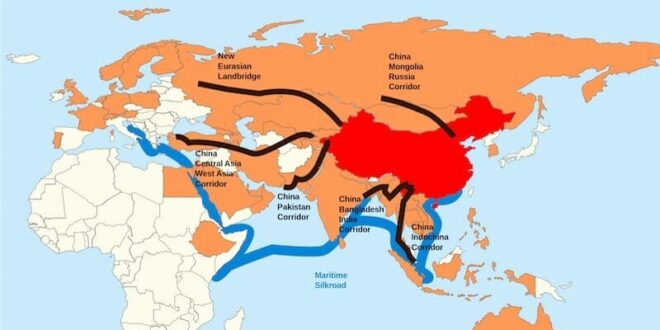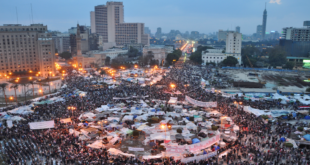In our globally interconnected world, roads are the arteries of economic progress. Thus, recent incidents, such as attacks by the Yemeni Houthis on cargo ships in the Suez Canal, emphasize the critical importance of secure transportation routes. As global attention pivots, the spotlight now converges on the Central Asian region—an important nexus able to interlink diverse corners of the world. In a period characterized by ever-increasing geopolitical tensions, the emergence of the Middle Corridor, as an alternative to established trade norms, isn’t merely an economic prospect – it is a transformative force that can switch powers and roles.
Throughout history, bridging the gap between Asia and Europe has been a persistent global interest – to enable or to prevent in its few possible modes (land or sea, warm sea – cold sea). The Northern Corridor, once a main land trade route, is experiencing a decline due to geopolitical tensions and Russia’s actions in Ukraine polarizing the world. The road under Russian control is losing its appeal for the west (at least for the time being), exacerbating the need for alternative and more stable pathways. North-South Corridor which was largely analyzed by the IFIMES researcher Lorenzo Somigli is another important road connecting Europe and East Asia.
Yet the Middle Corridor weaves a transformative thread that passes through strategic countries like Kazakhstan, Azerbaijan, and Georgia, offering numerous economic opportunities. The European Bank for Reconstruction and Development (EBRD) in their last year publication concluded that the Central Trans-Caspian Network (CTCN) that goes through Southern Kazakhstan is the most sustainable alternative for establishing a connection between Asia and Europe (2023).
The interest in this transport route lies, first of all, in the potential opportunity to reduce the time in which goods can be delivered from East Asia to Europe, which will be only twelve days. In comparison, the Northern Corridor takes nineteen days to complete, while the traditional sea pathway through the Indian Ocean takes up to thirty-seven days (Jafarova, 2023).
Within this changing geopolitical terrain, the transformation in how Central Asia interacts with the global community has become a topic of considerable change and fascination. The Middle Corridor is not a mere choice, it is rather a necessity for countries that seek to broaden trade associations while mitigating geopolitical risks while benefiting all actors. The Middle Corridor is an opportunity to change the trade patterns in the whole of Eurasia while redefining established spheres of influence.
EU: Elevating Diplomacy
In the past year, there has been a significant upraise in diplomatic meetings that underscore the heightened interest of the European Union in boosting ties with Central Asian countries. Examples include Emmanuel Macron from France visiting Kazakhstan and Uzbekistan (Vock, 2023), along with German Chancellor Olaf Scholz and President Frank-Walter Steinmeier hosting Central Asian leaders to bolster diplomatic relations (Euractiv, 2023), as well as introducing such policies as Hungarian “Open to the East” (Toth, 2023). Dependent on Chinese supplies, the EU sees the Middle Corridor as an alternative that will substitute the Northern Corridor.
Furthermore, besides counteracting Russian dominance in the region, the corridor aligns with the EU’s broader strategy of engagement with resource-rich Central Asia, offering energy security and diversified supply chains. The region is rich in natural resources that include fossil fuels and minerals. The concern is of the highest importance to the European countries, especially in light of the ongoing energy crisis stemming from reliance on Russian energy supplies (Cam, 2023), further emphasized by the European REPowerEU Plan, which aims to shift away from dependence on Russian sources and transition towards green energy alternatives (so far more a political vision than an attainable goal). On top of that, energy and minerals are playing an important role in the development of the EU and Central Asian relations. During the first official visit of French President Emmanuel Macron, alongside President of Kazakhstan Kassym-Jomart Tokayev, they made a shared declaration to enhance trade and collaboration in nuclear energy and minerals (Teslova, 2023).
Following the groundwork on Polar security, demography, economy and transport of prof. Anis H. Bajrektarevic as well as fundamental analysis of the railroad infrastructure in in Eurasia’s east and southeast one by the WIIW Director Dr. Mario Holzner, numerous European investors have already displayed their considerable interest in the project. For example, Austrian Federal Railways (ÖBB) together with Pasifik Eurasia presented one more solution for the Middle Corridor that will be a connecting point for Asia and Europe, which is Köseköy Terminal (Zhang, 2023). Meanwhile, the EBRD is planning to invest over US$100 million into Kazakh railways (Usov, 2022).
China: Strategic Investments and Commitments
Central Asia finds itself situated between two major powers, Russia and China, both of which significantly influence the region’s policies. From Beijing’s strategic standpoint, the Middle Corridor offers to China a trade route which does not crosses Russian proper. China’s attraction to the Middle Corridor stems from the prospect of accessing global markets and expanding influence in Central Asia, a region historically marked by competition between Moscow and Beijing.
According to the analysis of a Senior IFIMES/DeSSA researcher, Dr. Maria Smotrytska, it can be claimed to be a part of the Chinese “Belt and Road” initiative, which is why the strategic value of the Middle Corridor prompts significant Chinese investment in the logistics infrastructure. The recent China-Central Asia summit in Xi’an at the level of the countries top leaders underscores China’s commitment to maintaining and strengthening its dominant economic role in the Central Asian region (Devonshire, 2023).
Moreover, Chairman Xi, in his speech said that China will support the construction of the Trans-Caspian International Transport Route, as well as increase the capacity of railway container terminals along the China-Europe route. The discussions during the summit also included regional matters such as visa exemption between Kazakhstan and China, the construction of a fourth branch of the gas pipeline in Turkmenistan, and the construction of a new railway in Uzbekistan. The outcomes of these discussions contribute directly to the development and viability of the Middle Corridor by addressing key aspects of connectivity, trade facilitation, and regional cooperation. Throughout history, China predominantly utilized Kazakhstan and Russia for its shipments. However, in the aftermath of the war outbreak and the enforcement of sanctions, rail transit between China and the EU via the northern corridor in Russia experienced a 34% decline in 2022 (Zhang, 2023).
Türkiye: A Strategic Hub and Cultural Ties
Türkiye is the European end of the Middle Corridor and at the same time, it is a country whose interest in it surpasses any other actor. It has strategically prioritized the Middle Corridor in its foreign policy for Central Asia as it is perceived as an avenue to strengthen economic bonds and enhance its strategic standing in the region. Türkiye shares a common heritage with the Central Asian region and therefore is inclined to play a more active and influential role in the region, seeking to strengthen cultural, economic, and political ties with its Turkic-speaking counterparts. The combination of Pan-Turkic sentiments and pragmatic foreign policy objectives contributes to Türkiye’s active participation in the Middle Corridor. It started in 2013 with the agreement on the Trans-Caspian International Transportation Route Development. Acknowledging its importance, such projects as the Marmaray undersea railway, the Eurasia Tunnel, and the Yavuz Sultan Selim Bridge are already completed.
In the meantime, Ankara is building strategic alliances with Kazakhstan and Azerbaijan in their connectivity initiatives. The Organization of Turkic States (OTS) includes the Central Asian region and Türkiye plays an important role in the development of the Trans-Caspian International Transport Route. The Turkic World Vision-2040 recently adopted by the OTS aims to integrate member states into regional and global supply chains through the Middle Corridor.
Current Dynamics: Toward Enhanced Competitiveness
The Middle Corridor is represented by states between which the Caspian Sea is located, and here cargo is transshipped through tankers. That is, cargo is unloaded at the ports of Aktau or Kuryk, then reloaded onto ferries, delivered to Baku, and from Baku by rail sent towards Georgian ports or Türkiye. In Georgian ports, they are again loaded onto ferries and delivered by sea to the countries of the Balkan Peninsula. The current situation forces the participating countries of the Middle Corridor to take several measures to increase the competitiveness of this route. In response to that, nations took a course of action engaging in active negotiations to harmonize tariffs and streamline bureaucratic procedures.
In early March of 2022, Kazakhstan, Azerbaijan, and Georgia agreed to enhance soft infrastructure by aligning regulations and lowering tariffs for transit cargo (Azertag, 2022). The Organization of Turkic States has played a crucial role in boosting the efficiency and competitiveness of the Middle Corridor through its initiatives as well. Türkiye itself has taken steps to streamline cargo shipments to southern Europe, introducing new high-speed trains and establishing a quadrilateral coordination council and rail transportation working group with Bulgaria, Serbia, and Hungary (Bovenizer, 2023). This initiative represents a crucial component in establishing the European segment of the Middle Corridor.
During the 20th Transport Sector Coordinating Committee (TSCC) meeting with delegations of all countries in the Middle Corridor and their strategic partners in the face of the Asian Development Bank (ADB), EBRD, Eurasian Fund for Stabilization and Development (EFSD), International Road Transport Union (IRU), and World Bank objectives for the 2024 work program were set under the CAREC Transport Strategy 2030. The main topics of discussion centered around the expansion of the physical capacity of the transport routes, the inclusion of new ports, ferries, and trains, as well as the enhancement of soft infrastructure to decrease the time of shipment. The need for developed infrastructure is rising as in 3 months, from January to March of 2022, only through the Middle Corridor, 266.300 tons of cargo was transited, which is 123 percent higher than in 2021 (Sharifli, 2022).
Conclusion
Ideologists and advocates of the Middle Corridor push the idea that it is relevant due to the actions of Moscow in Ukraine, which allegedly interrupted the supply chains through the territory of Russia and Belarus from China to Europe. It would be wrong to associate the investments in the alternative route only with war and sanctions. Every local or external actor has its own interest – political, strategic, security and economic, short-mid and long term.
The EU and the United States have long been interested in alternative transport routes bypassing Russian and Belarusian territories to push Moscow and Minsk out of global trade flows. Taking into account the ongoing war in Ukraine, the US and the EU have even more incentives to do so. China made a major contribution to the creation and development of railway communication with Europe as it wanted to reduce its dependency on the narrow Strait of Malacca which can be closed by the US.
Implementing all the required enhancements will make the Corridor a faster and cheaper alternative. The Middle Corridor requires an increase in capacity, more advanced technologies, enhanced soft infrastructure, and optimization to ensure meeting its competitive lead times, transit costs, and efficiency. After all, in the world of increased ‘binary categorizations’ (Bajrektarevic, 2022), de-escalation would mean more middle ground, more listening, finally more inclusion. If so, the Middle Corridor should not be necessarily seen as an alternative to the Northern one. If we are serious on ‘de-binarisation’ and on greening of this planet, we have to accept obvious: the world’s largest landmass is huge enough for more than one, even two corridors. And, they should complement, not exclude or compete one another.
 Eurasia Press & News
Eurasia Press & News



